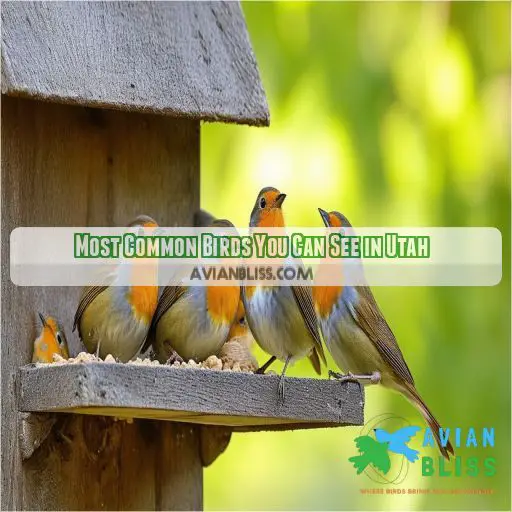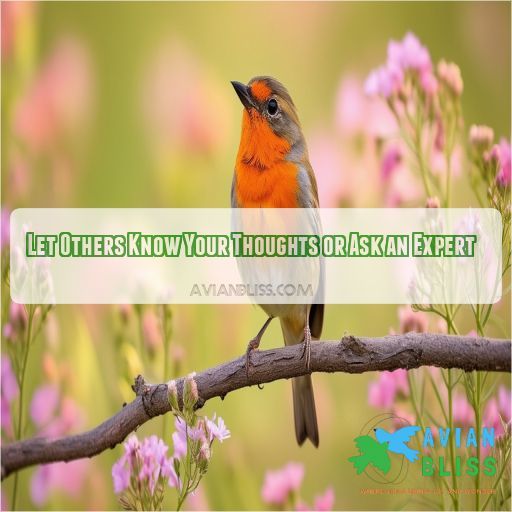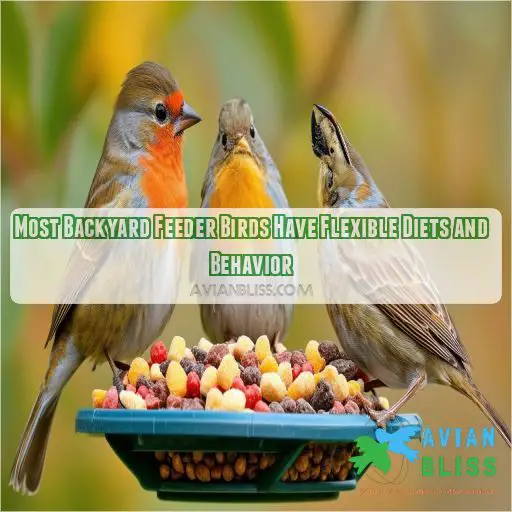This site is supported by our readers. We may earn a commission, at no cost to you, if you purchase through links.

From the powerful Golden Eagle to the lovely Mountain Bluebird, Utah is home to an array of beautiful western species.
We’ll explore the top 9 common birds you can spot right in your backyard, with a scientific and detailed approach.
Get ready to learn about the unique behaviours and habitats of these feathered friends and identify them like an expert.
Table Of Contents
- Key Takeaways
- Most Common Birds You Can See in Utah
- Let Others Know Your Thoughts or Ask an Expert
- Most Backyard Feeder Birds Have Flexible Diets and Behavior
- Common Birds Identification by Color
- How Can I Identify a Bird in My Yard?
- Frequently Asked Questions (FAQs)
- How can I identify a bird in my yard?
- What is the most common bird in Utah?
- How do I know what birds are in my area?
- What is the gray and yellow bird in Utah?
- What are good birdwatching spots in Utah?
- How do I attract birds to my yard?
- What types of birds visit Utah in the summer?
- How can I identify a birds song?
- What do birds typically eat in my backyard?
- Conclusion
Key Takeaways
- Utah is home to a diverse range of bird species, from the powerful Golden Eagle to the colorful Mountain Bluebird.
- Common birds you can spot in backyards across Utah include the American Robin, House Finch, Mallard, Common Raven, and Black-billed Magpie.
- Bird enthusiasts can connect with local birding communities, use online resources, visit designated birdwatching areas, and participate in citizen science projects to learn more about Utah’s avian inhabitants.
- Understanding the dietary preferences and feeding behaviors of backyard birds in Utah is key to attracting specific species, with many frequenting backyard feeders for a variety of food sources.
Most Common Birds You Can See in Utah
You can spot a variety of birds in Utah’s diverse habitats, from parks and woodlands to deserts and wetlands. Some of the most common species you may encounter include the American Robin, House Finch, Mallard, Common Raven, and Black-billed Magpie.
American Robin
The American Robin is a common sight in Utah, with its dark gray plumage above and brick red and white below. You can spot these birds in a variety of habitats, from parks to towns. Keep an ear out for their song and watch for their nesting habits to help with bird identification.
House Finch
House finches are sparrow-sized birds with dark, rounded beaks and fairly long wings. Here are some key characteristics:
- Male Plumage: Males have distinctive orange-red or rose-red plumage on their head, throat, and breast, with a hint of red on their rump.
- Female Plumage: Females lack the red plumage and are mostly streaked with dull brown-gray feathers.
- Nesting Habits: They build soft cup nests on trees, building ledges, or spots with overhanging cover.
Mallard
Mallards are fairly large, familiar ducks.
Male mallards have metallic green heads, yellow bills, a narrow white ring around the neck, and a chestnut breast.
Females are mottled brown and buff with a dark crown and line through the eyes, and a dark gray and orange beak.
Mallards are water birds, often found in wetland habitats like ponds and marshes.
They’re migratory birds, and you can spot them at the Great Salt Lake.
Common Raven
You might spot the common raven, a big, black crow-like bird with long, broad wings and a wedge-shaped tail. Here are some interesting facts about this bird:
- Soaring or Direct Flight: Ravens are often seen soaring or giving a few strong flaps between glides during direct flight.
- Omnivorous Diet: These birds are omnivores, feeding on carrion, small animals, nesting birds, and various other food sources.
- Diverse Habitat: They can be found in wilderness areas, from the Arctic to parts of the northeastern and western USA.
- Bulky Nests: Ravens build large, bulky nests out of sticks, lined with mud, wool, and other materials, often on cliffs, trees, bridges, or other structures.
Black-billed Magpie
The black-billed magpie is a distinctive bird with bold black and white plumage, a long tail, and a stout, crow-like beak. Its wings and tail have glossy green and purple iridescence, and it shows bold white wing patches in flight. Magpies are social birds, often seen in groups, with a flight pattern characterized by a few flaps followed by short glides. They’re omnivorous, with a varied diet, and build domed nests from sticks and mud in trees or on structures.
| Bird Name | Appearance | Habitat |
|---|---|---|
| Black-billed Magpie | Black and white with a long tail | Open, semi-open, and wooded areas |
| Glossy green and purple in wings and tail | ||
| Stout, crow-like beak | ||
| Magpie Habits | Social, often in groups | |
| Magpie Diet | Omnivorous, varied | |
| Magpie Sounds | ||
| Magpie Nesting | Domed nests of sticks and mud |
Let Others Know Your Thoughts or Ask an Expert
Now that you’ve gotten to know some of Utah’s common birds, you might be wanting to learn more or seek expert advice. Here are some options:
- Connect with Local Birding Communities: Join local bird clubs or nature societies in Utah. These groups often organize birdwatching trips, provide educational resources, and offer opportunities to connect with experienced birders who can offer guidance and insights.
- Online Birding Platforms: Utilize online resources, such as birdwatching apps, to access identification guides, track sightings, and connect with other bird enthusiasts. These tools can be especially helpful when you’re trying to identify a bird you’ve spotted but can’t quite name.
- Visit Designated Birdwatching Areas: National parks and wildlife refuges in Utah often have designated trails and observation areas specifically for birdwatching. These spots are chosen for their diverse bird populations and offer excellent opportunities to see birds in their natural habitats.
- Citizen Science Projects: Participate in citizen science projects, such as those run by the Cornell Lab of Ornithology. By submitting your bird sightings and data, you contribute to scientific research and conservation efforts while also learning more about bird behavior and populations.
Most Backyard Feeder Birds Have Flexible Diets and Behavior
Most backyard feeder birds in Utah have flexible diets and behavior. They adapt to different food sources and feeding locations, making them regular visitors to bird feeders. Understanding their preferences is key to attracting specific species to your yard.
For example, sparrows, finches, chickadees, doves, and nuthatches are all frequent visitors to backyard feeders. These birds have diverse diets, including seeds, buds, fruits, and insects. They’re comfortable with various feeder types, from platform feeders to ground feeding, and some even prefer specific seeds like hulled sunflower or nyjer.
Common Birds Identification by Color
Identifying birds by color is a helpful way to recognize species. You can find black birds like the European starling, blue birds like the mountain bluebird, and yellow birds like the American goldfinch in Utah.
Black Birds
If you’re looking to identify black birds in Utah, there are a few common species you might encounter:
- European Starling
- Red-winged Blackbird
- Great-tailed Grackle
These birds are easily recognizable by their black feathers, which cover most of their bodies. Here are some additional details to help with identification:
- Red-winged Blackbird: Look for the distinctive red and yellow patches on the male’s wings, which are visible during flight or when displaying.
- European Starling: These birds have iridescent feathers that shine with a purple or green hue in the right light.
- Great-tailed Grackle: Larger than other blackbirds, with a long tail and a dark iridescent sheen.
Blue Birds
Bluebirds are colorful, cheerful birds that can be spotted in Utah.
The Western Bluebird and the Mountain Bluebird are two blue bird species commonly found in the state.
These birds have beautiful blue plumage and are a delight to observe.
They can be seen in a variety of habitats, including mountainous regions.
Bluebirds typically feed on insects and small invertebrates, and they may visit backyards with suitable food sources.
Their nesting habits vary, but they often build nests in cavities or nest boxes.
During migration, bluebirds may travel long distances, so keep an eye out for these vibrant birds as they pass through Utah.
Yellow Birds
Now, let’s move on to the sunny and cheerful yellow birds you might spot in Utah. These bright birds will bring a smile to your face and a splash of color to your backyard. Keep an eye out for these four feathered friends:
- American Goldfinch
- Yellow-rumped Warbler
- Western Meadowlark
- Yellow Warbler
How Can I Identify a Bird in My Yard?
Identifying birds in your yard can be a fun and rewarding activity. Here are some tips to help you become a bird ID expert:
- Look for field marks: Distinctive features like color patterns, bill shape, and tail length can help identify a bird. For example, the American Robin has a dark gray back, brick red and white underparts, and white corners in its outer tail feathers.
- Listen to bird sounds: Birds have unique calls and songs. You can learn to recognize common birds by their vocalizations. Mockingbirds, for instance, are known for their ability to mimic a variety of sounds.
- Use bird apps and guides: There are many helpful resources available, such as field guides, birdwatching apps, and local bird clubs, to aid in identification. These tools can provide information on appearance, calls, and habitat, making it easier to pinpoint that mystery bird.
With these tips and a bit of practice, you’ll be well on your way to identifying the woodpeckers, wrens, robins, mockingbirds, and black-capped chickadees that may visit your yard. Happy birding!
Frequently Asked Questions (FAQs)
How can I identify a bird in my yard?
Identifying birds in your yard can be enjoyable and rewarding. A guide with identification pictures, songs, and calls of birds can help. Note the size—small, medium, or large. Look for distinctive features like black caps, beaks, and white cheeks. Male, female, and juvenile plumages differ.
What is the most common bird in Utah?
The American Robin is the most common bird in Utah, accounting for 47% of all observed birds in the state. Other common birds include the Barn Swallow and the Downy Woodpecker.
How do I know what birds are in my area?
Knowing the birds in your area is a fun and rewarding hobby. 5% of backyard feeder birds in Utah use platform feeders. To identify birds, note behavior, voice, color, and field markings. You can also use the free Merlin Bird ID app or buy a field guide.
What is the gray and yellow bird in Utah?
The gray and yellow bird you’re thinking of could be a MacGillivray’s Warbler, an Evening Grosbeak, a Yellow-rumped Warbler, or a Western Kingbird.
What are good birdwatching spots in Utah?
Utah has many great birdwatching spots, including Farmington Bay WMA, Fish Spring National Wildlife Refuge, Matheson Preserve, and Beaver Dam Wash.
How do I attract birds to my yard?
Place feeders, birdbaths, and plants in your yard. Birds need water, shelter, and food. Space out food and shelter to maximize bird traffic. Choose bird-friendly plants, like fruit-bearing shrubs, and trees for perching and nesting.
What types of birds visit Utah in the summer?
In the summer, you’ll see wrens, bluebirds, warblers, hummingbirds, sparrows, thrushes, and the occasional American Pipit and Townsend’s Solitaire. The Yellow Warbler, Western Kingbird, and Black-chinned Hummingbird are more common in the summer. The Plumbeous Vireo and Green-tailed Towhee are also summer visitors.
How can I identify a birds song?
Go somewhere accessible like a park or your garden, especially near trees and bushes. Early morning and the hour before sunset are when birds sing the most. Focus on the most frequent calls and listen before you look. Think about rhythm, tone, and pitch. Use apps like BirdGenie to record and identify bird songs.
What do birds typically eat in my backyard?
Common backyard birds in Utah eat a variety of foods, including insects, seeds, grains, and fruit. Mallards, for example, eat insect larvae, snails, and seeds. Black-billed magpies eat carrion, small animals, and seeds.
Conclusion
Whether you’re a novice or an expert, the backyard birds of Utah offer a fascinating glimpse into the state’s diverse avian life.
From the vibrant American Robin to the majestic Golden Eagle, we’ve explored the top common species you can spot right in your backyard.
With a scientific eye, we’ve looked closely at their unique behaviours and habitats, offering a detailed guide to identification.
Now, armed with this knowledge, you’re ready to become a backyard birding pro and share your own insights and stories.








